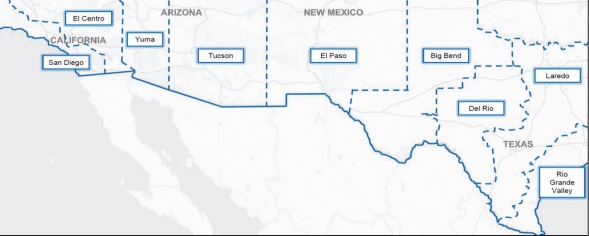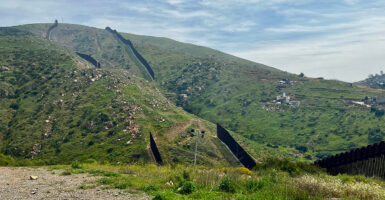A man made his way along a dirt path in Tijuana, Mexico, toward the large gap in the U.S.-Mexico border wall Friday morning. He carried a backpack and walked with ease through the more than 100-yard opening into Otay Mesa, a community in San Diego County, California.
No Border Patrol agents were in sight. A source working alongside agents in the San Diego Sector told The Daily Signal on Friday that Border Patrol was short-staffed, only having a fraction of the agents needed to cover California’s border with Mexico.
The man who entered through the gap Friday did not appear concerned about whether he was seen entering the country illegally, but also appeared hesitant to encounter strangers, maintaining a significant distance between himself and The Daily Signal reporting team.
If the wall had been completed in Otay Mesa, would the man with the backpack still have found another way to enter the country illegally? In other words, do walls alone stop illegal immigration?
Trump vs. Biden on Border Walls
Construction was underway to extend the border fence 3 miles through the Otay Mountain Wilderness under President Donald Trump, The San Diego Union-Tribune previously reported. And the materials to finish the project, according to local landowners who recently spoke with The Daily Signal, were ready to be used to complete the barrier between Otay Mesa and Tijuana.
But under the Biden administration, construction was halted, and the wall materials were removed from the area. Today, a large gap in the wall remains in the mountainous region.
On his first day in office, President Joe Biden signed an executive order declaring that “building a massive wall that spans the entire southern border is not a serious policy solution. It is a waste of money that diverts attention from genuine threats to our homeland security.”
Case Study of the San Diego Sector
The San Diego Sector, one of nine sectors along the southern border, presents an interesting case study on the effectiveness or ineffectiveness of border walls and policy related to U.S. border security.

Illegal crossings into the San Diego Sector are not new.
“San Diego Sector’s primary operational area of responsibility consists of 7,000 square miles, including 60 linear miles of international boundary with Mexico and 114 coastal border miles along the Pacific Ocean,” according to Customs and Border Protection.
Throughout the 1970s, ’80s, and into the ’90s, the San Diego Sector consistently experience more illegal crossings than any other southern border sector. In fiscal year 1980, for example, Border Patrol encountered 285,984 illegal aliens in the San Diego Sector. The El Paso Sector, which includes all of New Mexico and a portion of western Texas, had the second-highest number of encounters that same year at 127,488.
In an effort to stem the vast number of illegal crossings into the sector, in 1994, “Border Patrol’s San Diego Sector introduced a new border control plan at Imperial Beach Station,” according to an archived Justice Department document. The plan was called Operation Gatekeeper.
Imperial Beach Station is one of eight Border Patrol stations in the San Diego Sector.
According to the Justice Department, Operation Gatekeeper focused on deterring and preventing illegal crossings, and shifted away from an emphasis on apprehensions.
Following Operation Gatekeeper’s implantation in the Imperial Beach Station, the plan was rolled out at the other seven stations in the sector.
In 1993, fencing was constructed out of steel landing mats along long stretches of the San Diego Sector border with Mexico starting at the Pacific Ocean, according to the Justice Department report.
The report notes that people were still able to climb over the barrier, but “the fencing serves two important functions: It provides a barrier to vehicles crossing the border with aliens and/or drugs, and it defines a clear line of demarcation between the two countries.”
Those initial efforts to stem the flow of illegal immigration into the San Diego Sector saw little result.
Border Patrol encountered 565,581 illegal aliens in 1992 before the implementation of Operation Gatekeeper or the building of long stretches of barrier. By 1996, the San Diego Sector was seeing slightly lower encounter numbers, ending the fiscal year with a total of 483,815—still the highest among all nine southern border sectors.
It was not until 2010 that the San Diego Sector began to see a large and sustained decrease in illegal border crossings, following Congress authorizing the building of 700 miles of border wall under the Secure Fence Act of 2006 during the Bush administration.
The construction of the border wall that began under then-President George W. Bush continued under President Barack Obama, including in the in the Otay Mountain Wilderness in California, where a gap remains today.
In 2007, total illegal southwest border crossings between ports of entry began to decline and did not see significant increase again until fiscal year 2019, at which time then-President Trump began implementing new policies to reduce the flow of illegal immigration, such as the “Remain in Mexico” policy. More fencing was also built under Trump.
Results
Between factors such as changes to Border Patrol policies and the building of border wall during the Bush, Obama, and Trump administrations, Border Patrol encounters between ports of entry on the southern border fell to 400,651 in fiscal year 2020, the final full fiscal year of Trump’s presidency. In the San Diego Sector, Border Patrol encountered 53,282 illegal aliens during the same year.
In fiscal year 2021, most of it under Biden’s administration, encounters in the San Diego Sector climbed back up to over 142,000, and across the southern border, encounters were more than 1.6 million, levels the Border Patrol had not come close to since before the building of the tall border wall in 2000.
Biden ended Trump’s “Remain in Mexico” policy and stopped all wall construction, but did not remove sections of previously built wall, yet has seen record high encounter numbers under his presidency.
In fiscal year 2022 and 2023, Border Patrol encountered more than 2 million illegal aliens in each 12-month period between ports of entry along the southern border.
Border Patrol data indicates illegal crossings have only declined significantly with both construction of border wall and during times when policies were in place to discourage entering the country illegally.

























